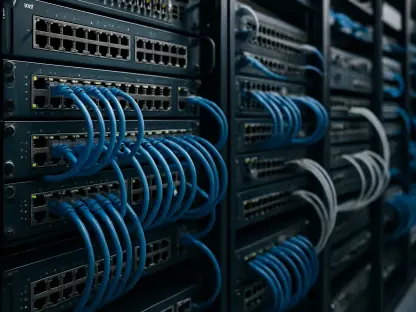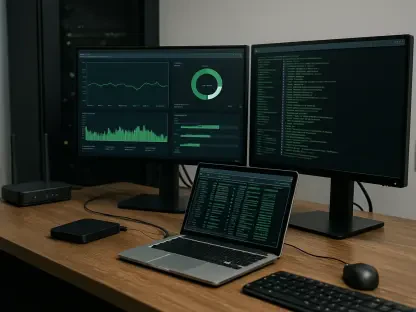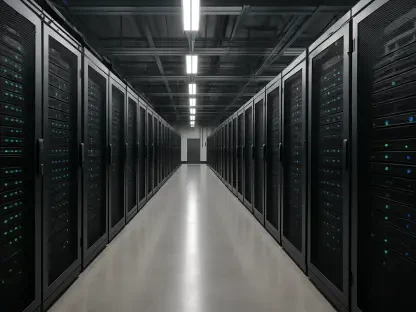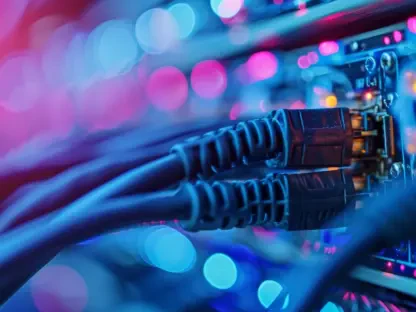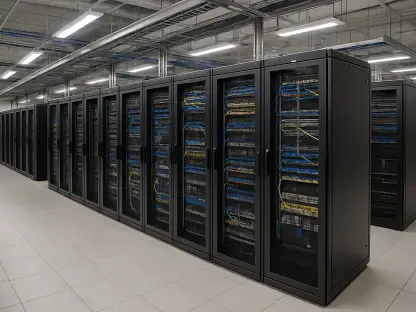In an era where network security stands as the backbone of organizational integrity, a newly discovered flaw in Cisco’s widely used IOS and IOS XE software has sent shockwaves through the tech community, demanding immediate attention from administrators worldwide to prevent potential breaches. Identified as CVE-2025-20352, this critical vulnerability within the Simple Network Management Protocol (SNMP) subsystem poses a severe threat, potentially allowing attackers to disrupt operations or seize control of affected devices. With real-world exploits already confirmed, the urgency to address this issue cannot be overstated. The flaw affects a range of hardware, including specific models like Meraki MS390 and Cisco Catalyst 9300 Series Switches, running vulnerable software versions. As cyber threats continue to evolve at an alarming pace, this situation underscores the critical need for proactive measures to safeguard essential network infrastructure against sophisticated attacks that could compromise entire systems.
Understanding the Threat Landscape
Unpacking the SNMP Subsystem Flaw
The vulnerability at the heart of this crisis, CVE-2025-20352, stems from a stack overflow condition within the SNMP subsystem of Cisco IOS and IOS XE software, creating a gateway for attackers to exploit unpatched devices. This flaw, carrying a CVSS score of 7.7, indicates a high level of risk, though not the most severe encountered in recent times. It enables two primary attack vectors: a denial of service (DoS) condition through a system reload triggered by a low-privileged attacker with access to SNMPv2c read-only community strings or valid SNMPv3 credentials, and a far more dangerous scenario where a high-privileged attacker with administrative access can execute arbitrary code as the root user. Such capabilities grant full control over the compromised device, posing a significant threat to network stability. Importantly, this issue spans all SNMP versions on affected systems, leaving no room for complacency among administrators managing vulnerable hardware configurations.
Real-World Exploits and Immediate Risks
Confirmation from the Cisco Product Security Incident Response Team (PSIRT) that real-world exploits have already occurred heightens the alarm surrounding this vulnerability, particularly as many successful attacks followed the compromise of local administrator credentials. While the requirement for authentication to exploit this flaw adds a layer of difficulty for casual attackers, it does little to deter sophisticated external actors or insiders with access to necessary credentials. The rapid development of exploit proofs-of-concept, accelerated by advancements in AI tools, further amplifies the danger, as noted by security experts. This situation emphasizes that even with authentication barriers, the risk remains substantial, especially for organizations slow to respond. Delays in addressing this flaw could lead to catastrophic disruptions, making it imperative for network teams to prioritize swift action to prevent potential breaches or operational downtime.
Mitigation Strategies and Expert Insights
Urgent Patching and Software Updates
In response to the critical nature of CVE-2025-20352, Cisco has released vital software updates, notably in IOS XE Software Release 17.15.4a, designed to eliminate this vulnerability from affected systems and protect against exploitation. Security experts universally stress the importance of applying these patches without delay, warning that procrastination could expose networks to severe consequences, including full system compromise or prolonged service outages. For administrators managing large-scale environments, the task of updating numerous devices may seem daunting, yet the potential fallout from inaction far outweighs the temporary inconvenience of deployment. Beyond patching, Cisco advises monitoring systems for unusual activity to detect early signs of exploitation. This proactive approach serves as a critical line of defense, ensuring that organizations remain vigilant against threats that could exploit this flaw before updates are fully implemented across all vulnerable devices.
Temporary Defenses for Unpatched Systems
For those unable to apply patches immediately due to operational constraints, Cisco offers interim mitigation strategies to reduce exposure while planning for comprehensive updates to secure their networks effectively. Restricting SNMP access to trusted users stands as a primary recommendation, significantly lowering the likelihood of unauthorized exploitation by limiting who can interact with the vulnerable subsystem. Additionally, administrators can disable specific object identifiers (OIDs) on affected devices, though this action may disrupt certain management functionalities like device discovery or inventory tracking. Utilizing command-line interface (CLI) tools such as the “show SNMP host” command also aids in monitoring and identifying potential risks. While these measures provide a temporary shield, they are not substitutes for permanent fixes. Experts caution that relying solely on mitigations could still leave systems at risk, particularly against determined attackers who might bypass these defenses through alternative means or compromised credentials.
Broader Implications and Strategic Concerns
Insights from industry professionals, such as Ed Dubrovsky of Cypfer, shed light on the nuanced risks associated with this vulnerability, particularly how authentication requirements do not fully mitigate threats from skilled adversaries or insider actors. Although less skilled attackers may struggle to exploit this flaw, motivated threat actors, including advanced persistent threats (APTs) or nation-state entities, could leverage it as an entry point for lateral movement within a network. While Cisco edge devices typically do not store sensitive data, their compromise could facilitate access to high-value systems if chained with other exploits. However, environments targeted by such sophisticated attackers often feature layered defenses that might reduce the likelihood of widespread exploitation. This perspective highlights the importance of viewing this vulnerability not in isolation but as a potential component of a larger attack chain, urging organizations to adopt a holistic security posture to address multifaceted risks.
Reflecting on Past Responses and Future Preparedness
Looking back, the response to CVE-2025-20352 underscored a pivotal moment in network security, where swift action by administrators who prioritized patching and implemented interim mitigations helped avert widespread damage across vulnerable Cisco IOS and IOS XE devices. The real-world exploits that occurred served as a stark reminder of the ever-present dangers in digital infrastructure, galvanizing many organizations to strengthen their defenses. Moving forward, the focus shifted to enhancing preparedness by integrating lessons learned into long-term strategies. Network teams were encouraged to establish robust update protocols, ensuring rapid deployment of patches for future vulnerabilities. Additionally, fostering a culture of continuous monitoring and restricting access to critical systems emerged as vital steps to bolster resilience. As cyber threats evolve, investing in advanced threat detection and cultivating partnerships with security experts became essential to anticipate and neutralize risks before they could escalate into crises.



